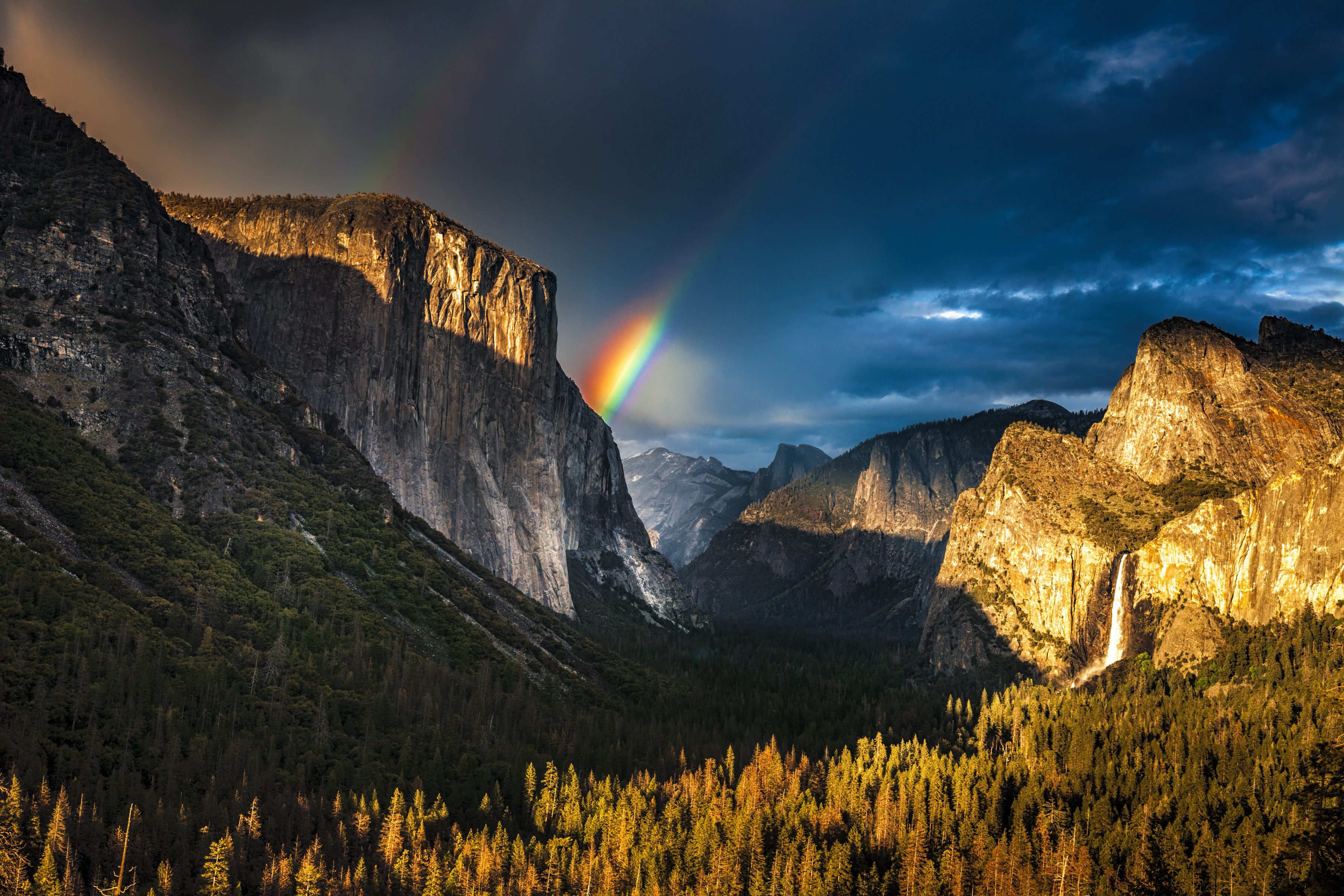July in Yosemite is when everything is on the table, including a wide variety of family-friendly fun. By July, all the high-country roads are open, the snow is off all but the highest trails, summer ranger programs are in full swing and everything is up and running. July is also when Yosemite’s summer temperatures reach their highest, so you’ll want to plan your days to keep cool, and the strategy for that is simple: start early or go high (or both). (Before your visit, take a peek at the interactive Current Conditions map on the NPS website. It is a terrific resource for information on weather, forecasts, webcams, and water flow in different parts of the park so you’ll know what to expect.)
Note: Yosemite National Park will require reservations to enter the park between on select dates, including July 1 through August 15, 2024. Fortunately, guests staying at The Redwoods In Yosemite Vacation Home Rentals, are not subject to the reservation system because all cabins are in Wawona, inside the park. If you have a valid Redwoods In Yosemite cabin reservation, simply show a copy of your booking confirmation (a screen capture is OK too), and a photo ID matching the reservation. You’ll be able to pay the entrance fee at the gate with a credit or debit card.
What To Do In Yosemite In July
With the entire park open from the lowest elevations to the highest, it can be hard to choose what to do in July in Yosemite. Bearing in mind that conditions vary from year to year, here are a few ideas.
Relaxing by a River or Playing in the Water with the Kids
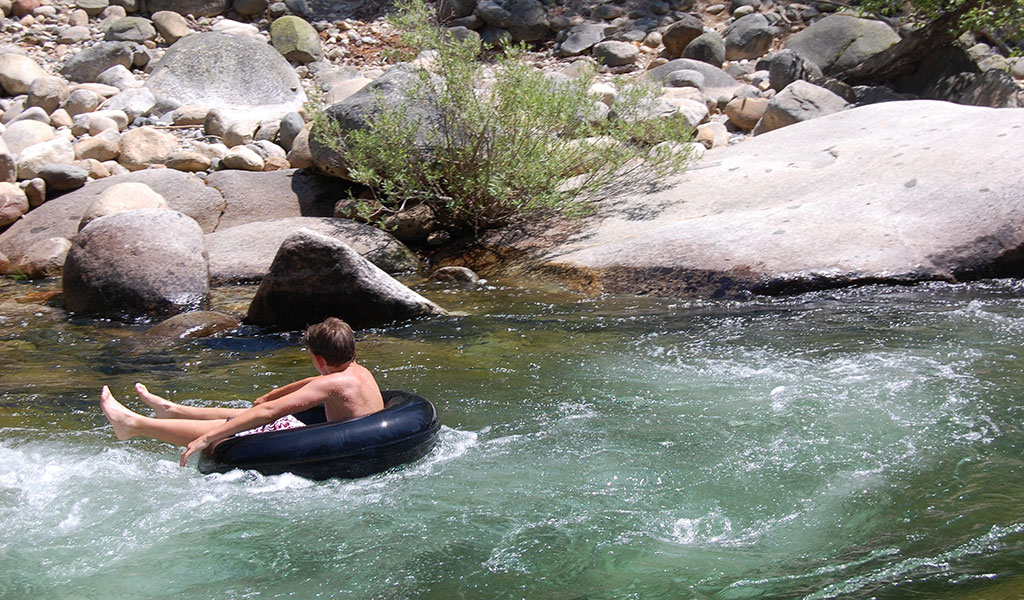
The area near the Wawona Swinging Bridge is also excellent for swimming and inner tubing when the water levels are right.
Many travel guides will give you step-by-step guides for how to pack it all in and get as much done as possible during the time you have. We’re going to break with that and say that we think a July day sitting by a river letting the water and the time flow by is a perfect way to spend a day in Yosemite. It’s a great way to spend some quiet time while kids play or to have some quality family time.
In general, the big spring flows are over and it is a safer time, but remember that even in July, currents can be fast and the water can still be cold. So if you are coming to Yosemite in July with kids, it’s important that any waterplay location be carefully selected with safety in mind.
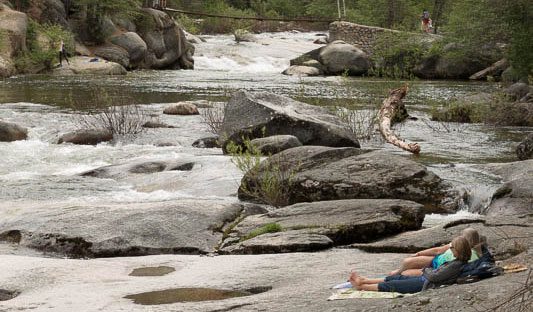
Wawona is also a great place to relax with a book down by the river. Photo: Theresa Ho
If you’re staying in Wawona, the South Fork of the Merced is never far. Like all Yosemite rivers, it can be a raging torrent and dangerous to enter in the spring. By July, however, it’s usually a meandering creek, perfect to sit by and read a book, listen for birds, dip your toes, and maybe even doze off while listening to the gurgle of the river or the unbridled laughter of the children as they splash about. The real pros might even bring a hammock to string between two shade trees. The area around Swinging Bridge in Wawona and near the picnic area between the village and Wawona Campground are great locations, but you can find your own spot anywhere along the river.
Naturally, a day spent on the banks of the Merced River in Yosemite Valley is another fine choice. There are countless options for this ranging from the “official” beaches like Cathedral Beach or Sentinel Beach, to any random spot that suits your fancy.
Even during the relatively mellow July days, be prudent about waterplay, especially with the little ones. Stay out of fast currents or “white” water (that is, any water with bubbles regardless of how tame it looks).
Rafting and Kayaking
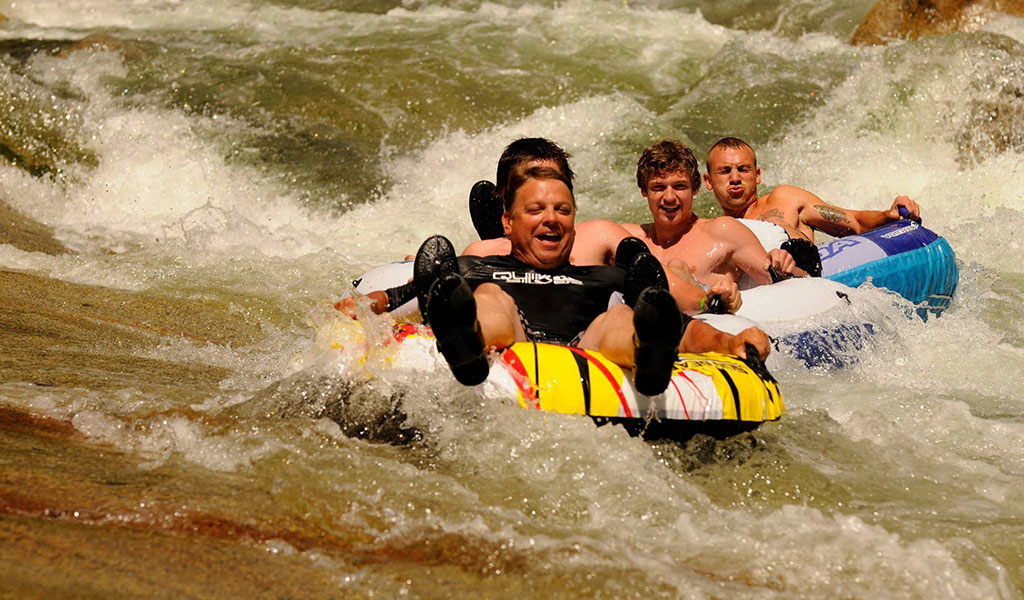
There is a splashing good time to be had on the rivers in Wawona.
There are two basic kinds of rafting available in the Yosemite area: wild spring whitewater just outside the park and a quiet meander down the Merced River in Yosemite Valley. July is rather late for the whitewater in most years.
Depending on the snowpack the previous winter, it can mark either the beginning of the season or the end of the season for the Merced Meander. This is not a thrill ride, but more of a family-friendly chill ride. Bring drinks and snacks and be prepared to jump in the water to cool off and then climb back in the boat to warm up. Experienced practitioners of the Merced Meander know that speed is not of the essence. Don’t wear yourself out paddling to break a record. Rather, relax and stare up at the Valley walls.
Raft rentals are available in Yosemite Valley. Those wishing to kayak or canoe need to bring their own watercraft. Note that in very low water years, the rafting may close before the end of July.
Ranger Walks
While ranger walks are few and far between in some seasons, in July there are usually multiple choices every day and in every section of the park. These walks are a great way to learn about the park and deepen your experience. If you have the kids along, don’t miss out on the chance for them to become Junior Rangers with their very own and very official Yosemite Junior Ranger badge. Consult the Yosemite Guide for a full schedule and details on the Junior Ranger program.
Hiking
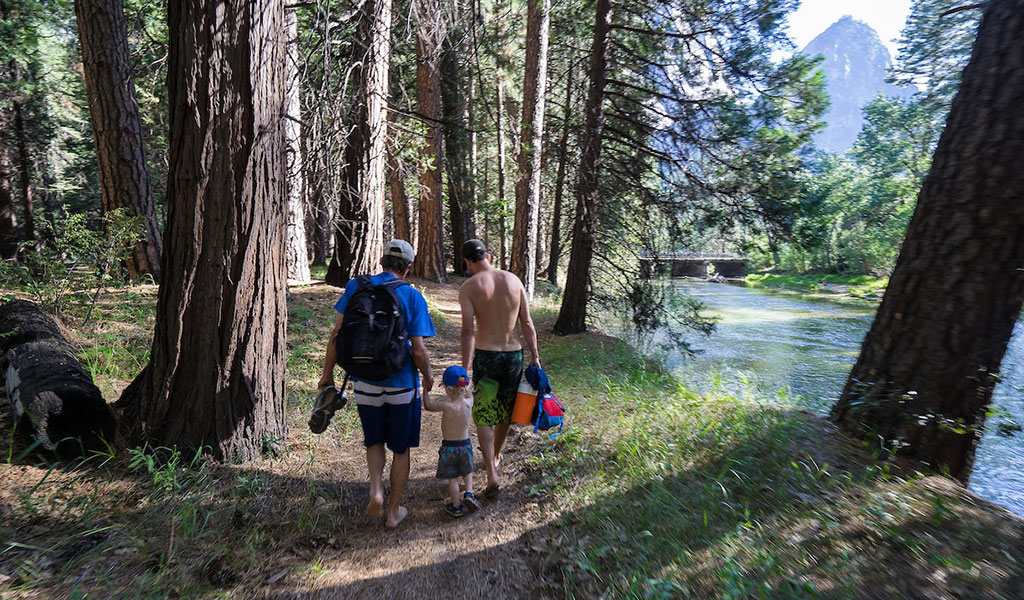
Take a walk out into nature. You don’t have to go far to reap big rewards in Yosemite.
Hiking is the most common activity in Yosemite and for good reason. By July you typically have the full range of choices from low-altitude hikes like the Wawona Meadow Loop or the Valley Floor Loop to high-altitude hikes leaving from the Tioga Road. Some hikes are short and flat and accessible to even the youngest and oldest walkers. Others are fitness tests, not to be taken lightly. Which hikes you pick depends on your desires and your fitness level, but in general, you will want to choose hikes that offer some shade or you will want to start early.
Mariposa Grove
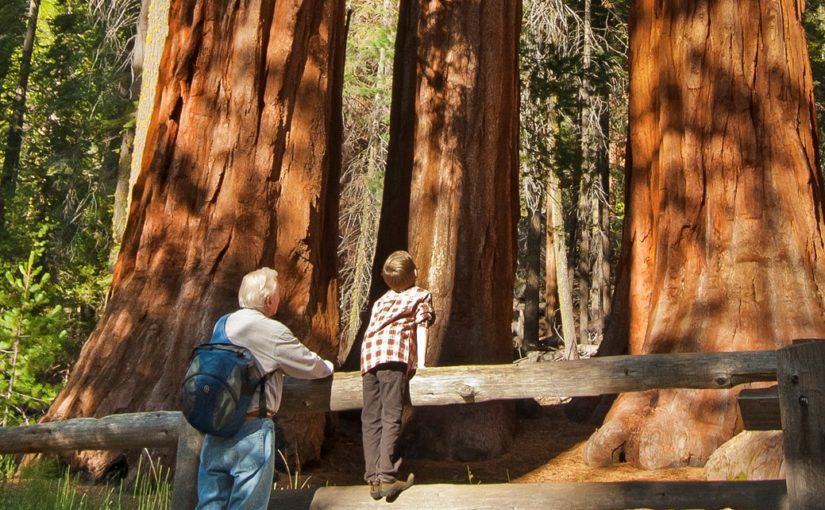
The Mariposa Grove of Giant Sequoia delights people of all ages. Photo: Nancy Robbins
The Mariposa Grove is one of the best July hikes in Yosemite. The grove is a bit higher than either Wawona or Yosemite Valley, and you walk under the shade of the tall trees, both giant sequoias and other conifers. The staggering size and beauty of the giant sequoias will naturally turn most hikes into a bit of a stroll. It’s hard not to stop and gawk and find it’s the trees, not the hiking, that take your breath away. And a picture of your small, young children next to an ancient, enormous sequoia tree is a memento they can cherish for the rest of their lives.
The Mist Trail
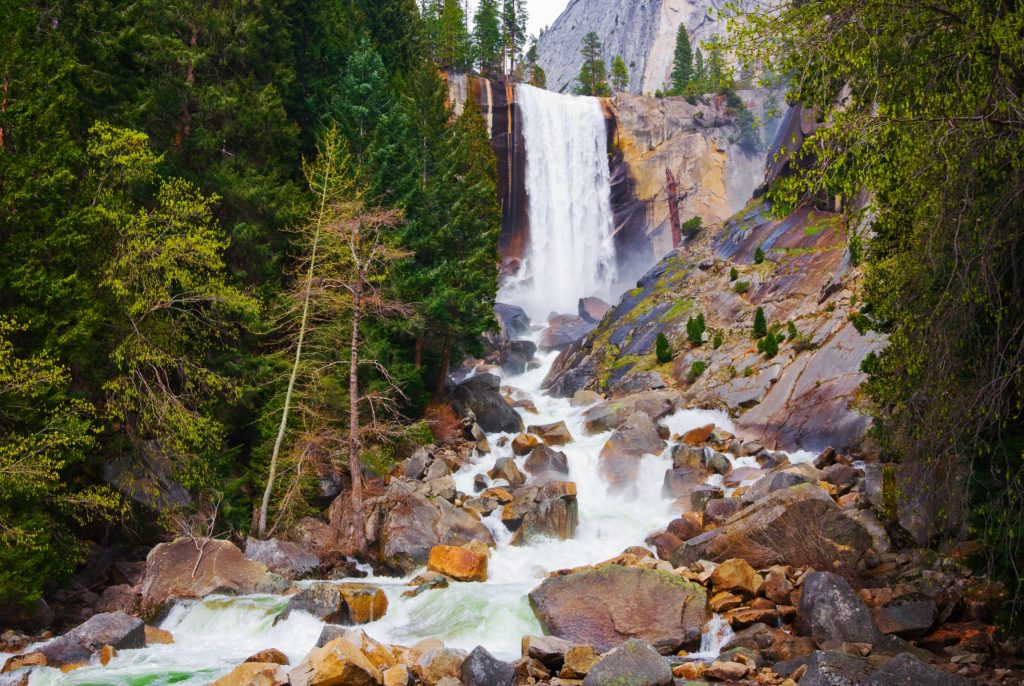
Yosemite’s Mist Trail is a popular must-visit destination, and the mist helps keep the trail cool in the summer.
The Mist Trail in Yosemite Valley is another excellent July choice for the same two reasons as the Mariposa Grove: it combines breathtaking scenery with nice shade cover. The trail takes you along one of the steepest parts of the Merced River as it cascades over the famous Vernal and Nevada Falls as well as through boulder-strewn riverbeds. That beauty does come at a price: the trail, like the river, is steep through this section. People unused to steep walking can find that the 2.5 miles to the top of Nevada Falls feels much longer and the rather large stone steps through the steepest part can be a challenge to younger children (or anyone, really, but young kids in particular). The good news is that the trail has excellent scenery along the entire length and there is no bad turnaround point. Walk as far as you want, have a picnic, declare victory and turn around. An excellent day out.
Wawona Meadow Loop
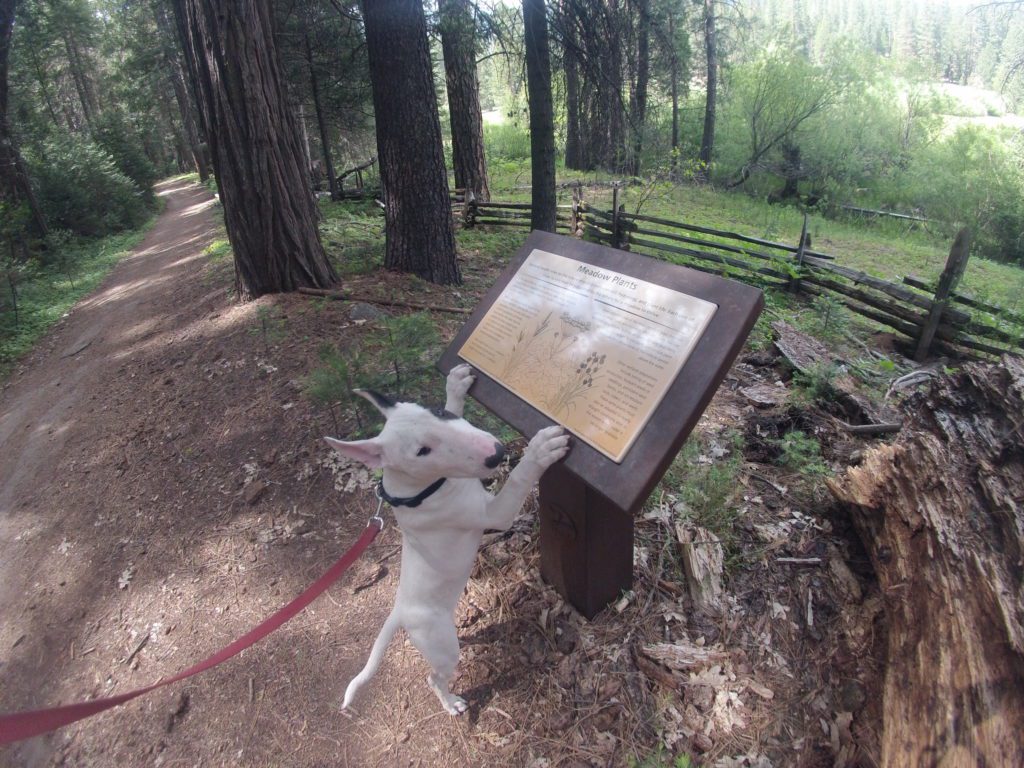
Take an easy stroll around the bike and dog friendly Wawona Meadow Loop.
The Wawona Meadow Loop offers a relatively flat and short outing with nice shade and is an easy way to quickly find a bit of quiet.
Go High
Another option is to gain some altitude. Sentinel Dome off Glacier Point is only a bit over a mile walk and brings you to over 8,000 feet with astounding panoramic views of Yosemite Valley, Half Dome and the Clark Range. Additional hikes at high altitude are more of a drive, but well worth it. There are countless opportunities in Tuolumne Meadows where the hikes all start at over 8,000 feet. The season up this high is only a few months long and July offers a great opportunity to see the “high alpine.”
Go Early
The other time tested summer strategy for hiking is simply to rise early and get going. Mornings are typically cool and comfortable, so the trick for trails like the Chilnualna Falls Trail or the Upper Yosemite Falls Trail is to get there in the cool of the morning and gain some altitude early. Once you’ve gotten a bit of altitude, you can find pleasant hiking all day long.
Essential Equipment
Sun Protection
The areas of Yosemite where visitors spend most of their time are all at 4,000 feet or higher, in some cases much higher. That means that the UV rays are stronger and sun protection is essential. That means covering up where you can (long sleeves recommended) and applying sunscreen liberally and frequently to your exposed skin. A wide-brim hat will keep your ears and face from burning. This is especially important for the younger ones with younger sensitive skin.
Staying Hydrated
The relatively low humidity in Yosemite is great for summer comfort, but can lead to dehydration if you’re not careful. It’s essential to carry water and salty snacks. Aside from the shortest strolls, plan to carry water wherever you go.
Extra Layers
Up in the mountains, the nights can cool down quickly. Just because you’re comfortable in a thin shirt and light pants when you leave the car, doesn’t mean you’ll feel that way as the sun goes down. In addition, you might encounter afternoon thundershowers, especially close to the Sierra Crest (like up in Tuolumne Meadows). At the same time, July is perhaps the most predictable time of the year and it is rare for it to get particularly cold. So a relatively light second layer and a light rain layer should be all you need unless you’re backpacking at high altitude.
Essential Strategy
There’s no sugar coating this: parking can be at a premium in July and the middle of the day can be hot. Starting early is the best way to ensure that you don’t spin your wheels (literally) looking for parking. Parking aside, an early start has the added benefit of getting you up and out in the cool of the morning when the walking is pleasant and you are most likely to see wildlife.
Where to Stay

You’ll love the option of having a full living room to relax in at The Redwoods In Yosemite.
If you can swing it, getting a place to stay inside Yosemite National Park is the best option for many reasons. You’ll be closer to the sights and experiences that you are looking for. That means less time cooped up in the car, and more time surrounded by nature. Plus, you’ll have automatically eliminated any worries about waiting in lines at the entrance gates.
There are several hotels inside the park that range from glamping experiences to historic elegance. You’ll need to book these far in advance for July dates.
Another great option is to get a vacation rental home at The Redwoods In Yosemite. With more than a hundred cabins all located inside the park in Wawona (close to the Mariposa Grove of Giant Sequoias), choosing a Redwoods In Yosemite cabin has many advantages. There is room for the family to spread out, or put young kids to bed early without having to worry about disturbing them. Kitchens allow you the option to pack inexpensive picnic lunches instead of always eating out. Private decks and BBQs mean bonus time in the outdoors – sipping a cup of coffee surrounded by morning birdsong, or a comfy spot to look out at the stars in the evening, all literally at your doorstep. Also, because The Redwoods has a central check-in, the staff are on-site to assist you if you need anything, and also a wonderful resource for local information and park knowledge.
Final Thoughts
Because the full gamut of summer fun is up and running in Yosemite in July, it’s impossible to give a complete guide, and we’ve only scratched the surface here. We haven’t even mentioned horseback riding or fly fishing or rock climbing classes or many other possibilities for a July visit. It is a time of the year when there is so much to do, it’s more a question of narrowing down the options than of figuring out how to fill up your time.
The key thing to remember, though, is that more isn’t better. People have come to Yosemite for generations to find quiet, to slow down, to breathe in nature, pass on a love of the outdoors from one generation to the next and get away from the bustle of their day-to-day lives. All that takes time. We recommend that you plan your trip around a few “highlight” activities on your “must do” list, but also to plan some time where you have nothing planned.
Relax and enjoy!

